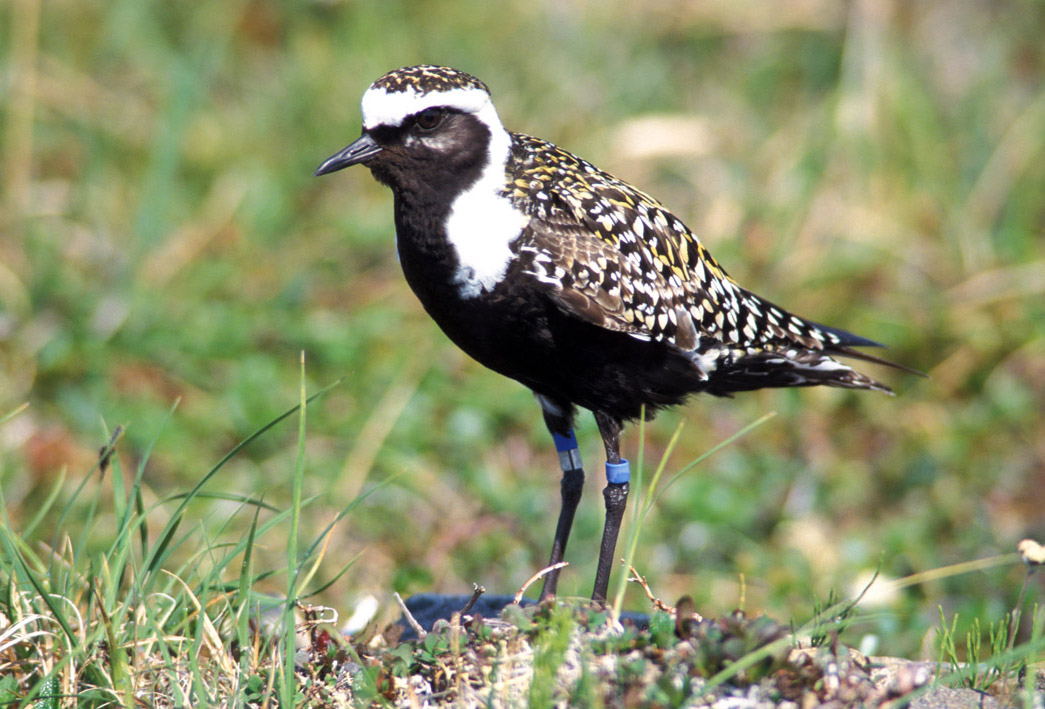- American Golden Plover
Taxobox
name = American Golden Plover
status = LC | status_system = IUCN3.1

image_width = 200px
regnum =Animal ia
phylum = Chordata
classis = Aves
ordo =Charadriiformes
familia =Charadriidae
genus = "Pluvialis "
species = " _la. P. dominica"
binomial = " _la. Pluvialis dominica"
binomial_authority = (Statius Muller ,1776 )
synonyms =" _la. Pluvialis dominica dominica"The American Golden Plover (" _la. Pluvialis dominica") is a medium-sized
plover .Adults are spotted gold and black on the crown, back and wings. Their face and neck are black with a white border; they have a black breast and a dark rump. The legs are black.It is similar to two other golden plovers, Eurasian and Pacific. The American Golden Plover is smaller, slimmer and relatively longer-legged than
Eurasian Golden Plover ("Pluvialis apricaria") which also has white axillary (armpit) feathers. It is more similar toPacific Golden Plover ("Pluvialis fulva") with which it was once considered conspecific under the name "Lesser Golden Plover". [Reviewed in Sangster "et al." (2002).] The Pacific Golden Plover is slimmer than the American species, has a shorter primary projection, and longer legs, and is usually yellower on the back.These birds forage for food on tundra, fields, beaches and tidal flats, usually by sight. They eat insects and crustaceans, also berries.
The breeding habitat of American Golden Plover is Arctic tundra from northern
Canada andAlaska . They nest on the ground in a dry open area. They are migratory and winter in northernSouth America . They follow an elliptical migration path; northbound birds pass throughCentral America about January-April [Strewe & Navarro (2004), Herrera "et al." (2006)] and stage in great numbers in places like Illinois before their final push north. In fall, they take a more easterly route, flying mostly over the westernAtlantic andCaribbean Sea to the wintering grounds inPatagonia . The bird has one of the longest known migratory routes of over 25000 miles, much of which it flies without stopping to eat or drink. It does this from body fat stores that it stocks up on prior to the flight. It is a regular vagrant to westernEurope .A comparison of dates and migratory patterns leads to the conclusion that
Eskimo Curlew s and American Golden Plovers were the most likely shore birds to have attracted the attention ofChristopher Columbus to nearby America in early October1492 , after 65 days at sea out of sight of land.cite web|title=Eskimo Curlew - A vanishing species? : The Eskimo Curlew's Year - Introduction to Oceanic Migration|url=http://www.npwrc.usgs.gov/resource/birds/curlew/oceanint.htm|author=J.B. Gollop, T.W. Barry, & E.H. Iversen|publisher=Nature Saskatchewan &United States Geological Survey |year=1986|accessdate=2007-12-22]Large numbers were shot in the late 1800s and the population has never fully recovered.
Footnotes
References
*|year=2004|id=49136|title=Pluvialis dominica|downloaded=11 May 2006 Database entry includes justification for why this species is of least concern
* (1986): "Shorebirds: an identification guide to the waders of the world". Houghton Mifflin, Boston. ISBN 0-395-60237-8
* (2006): Nuevos registros para la avifauna de El Salvador. ["New records for the avifauna of El Salvador"] . "Boletín de la Sociedad Antioqueña de Ornitología" 16(2): 1-19. [Spanish with English abstract] [http://www.sao.org.co/publicaciones/boletinsao/01-Herrera.etal.RecordsSalvador.pdf PDF fulltext]
* (2002): Taxonomic recommendations for European birds. "Ibis" 144(1): 153–159. DOI|10.1046/j.0019-1019.2001.00026.x [http://www.blackwell-synergy.com/doi/pdf/10.1046/j.0019-1019.2001.00026.x PDF fulltext]
* (2004): New and noteworthy records of birds from the Sierra Nevada de Santa Marta region, north-eastern Colombia. "Bull. B.O.C." 124(1): 38-51. [http://www.alpec.org/Articulo%20BBOC/Strewe%20&%20Navarro%202004%20BBOC%20124%20(1).pdf PDF fulltext]External links
* [http://www.enature.com/flashcard/show_flash_card.asp?recordNumber=bd0659 ENature.com]
Wikimedia Foundation. 2010.
